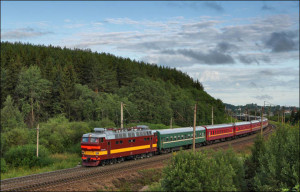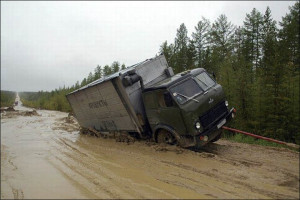Mark Marich
A different weblog for different people
Trans-Eurasian Belt Development: A Long Trip Home

Traveling. This is something that almost everyone is dreaming about. When asked a question “What do you want to do when you grow up” so many people usually answer “I would love to to see the world”. We can use trains, cars or bikes to travel but usually when one is talking about traveling between countries, one means using a plane for transportation.

The proposed plan for a massive trans-Siberian highway would link Russia’s eastern border with the U.S. state of Alaska. Photo Credit: CNN
Why do we need it?
If completed, this will be the longest route in the world and it will go through 3 continents: North America, Asia and Europe. Basically this is a dream of many characters in the movie “Around the world in eighty days“.
Proposals have been put forward to build the mega route stretching about 12,400 miles from the western edge of Russia to the Bering Strait where the country nudges Alaska.
But, do we actually need such highway?
“This is an inter-state, inter-civilization, project. The project should be turned into a world ‘future zone,’ and it must be based on leading, not catching, technologies.” – Vladimir Yakunin

The head of the Russian Railways Vladimir Yakunin presented the idea for the Trans-Eurasian belt Development (TEPR). Photo Credit: ITAR-TASS
This project is going to cost trillions of dollars. But apparently, the economic value that this route could bring is even bigger. This is what could happen if the idea is successful:
- Creation of new cities and development of the old ones
- Huge number of new jobs
- Development of Siberia and Far East in general
- Cheaper traveling, since less demand for planes
- Less trafic for existing interstate and between-countries routes
“The Project is very ambitious and expensive but it would solve many problems in the development of the vast region” – Vladimir Fortov, Head of the Russian Academy of Science
So, basically, this quote represents the whole idea. Trans-Eurasian Belt Development is arguably the most ambitious project in recent years but it could pay off a lot.
So… Where are we?
Trans-Eurasian Belt Development is a big step in connecting people in different parts of the world, bringing them together from isolations that they face since they live far-far away from the closest road.
TEPD will connect major cities in Europe, Asia and North America. The road would run across the entirety of Russia, linking with existing road systems in Western Europe and Asia. The distance between Russia’s western and eastern borders is roughly 6,200 miles and this huge distance will be covered by the road. As for know, it is very hard to drive in Russia, since most of the roads that connect towns and cities in Siberia do not even have asphalt. They are simple covered with dirt that makes them almost unusable.

The Kolyma Road in Russia. Photo Credit: Siberian Times
The road would likely connect Russia with North America via Russia’s far eastern Chukotka region, across the Bering Strait and into Alaska’s Seward Peninsula. It also will connect Europe with high-speed railway system.
It will almost definitely go through cities like:
- New York, USA
- Nome, Alaska, USA
- Fairbanks, Alaska, USA
- Uelen, Russia
- Moscow, Russia
- Berlin, Germany
- London, Great Britain
Let’s travel!
Trans-Eurasian Belt Development is going to cost trillion of dollars and it will be one of the most expensive projects in the history. But at the same time there are so many benefits that this project can bring.
Connecting people, bringing them together and creating communities is essential for our society. People in towns with no proper roads will be able to get good food, go to better schools and go to better jobs. Their existence will simply be better and they will be in better conditions.
Yes, this project is extremely ambitious and there are so many “but”s that can be added to it and there are so many obstacles and difficulties that will be faced. But all of that later. As for now, this is a great idea. Expensive, but great!
Cover Photo Credit: The Siberian Times
One Comment on “Trans-Eurasian Belt Development: A Long Trip Home”
Leave a Reply
You must be logged in to post a comment.
Mark, you have got an interesting article! Although your article is focused on the tourism aspect of railroad transport, I truly believe a railroad system is imperative for the development of a country. Railroad transport is efficient, flexible, reliable, cost-effective, and safe – whether it is used to carry passengers, heavy cargo, or both! Although building the railroad infrastructure requires hefty investments, the operating costs aren’t nearly as expensive as other modes of transport – especially road transport. In fact, The Association of American Railroads estimates that on average, a freight train can move 1 ton of freight about 484 miles on just one gallon of fuel. Having said that, it makes sense for developing countries, like Russia, where even the most basic infrastructure such as asphalt covered roads are not readily available to build an expansive railroad system.
http://www.mnn.com/green-tech/transportation/questions/which-is-more-efficient-for-freight-truck-or-train